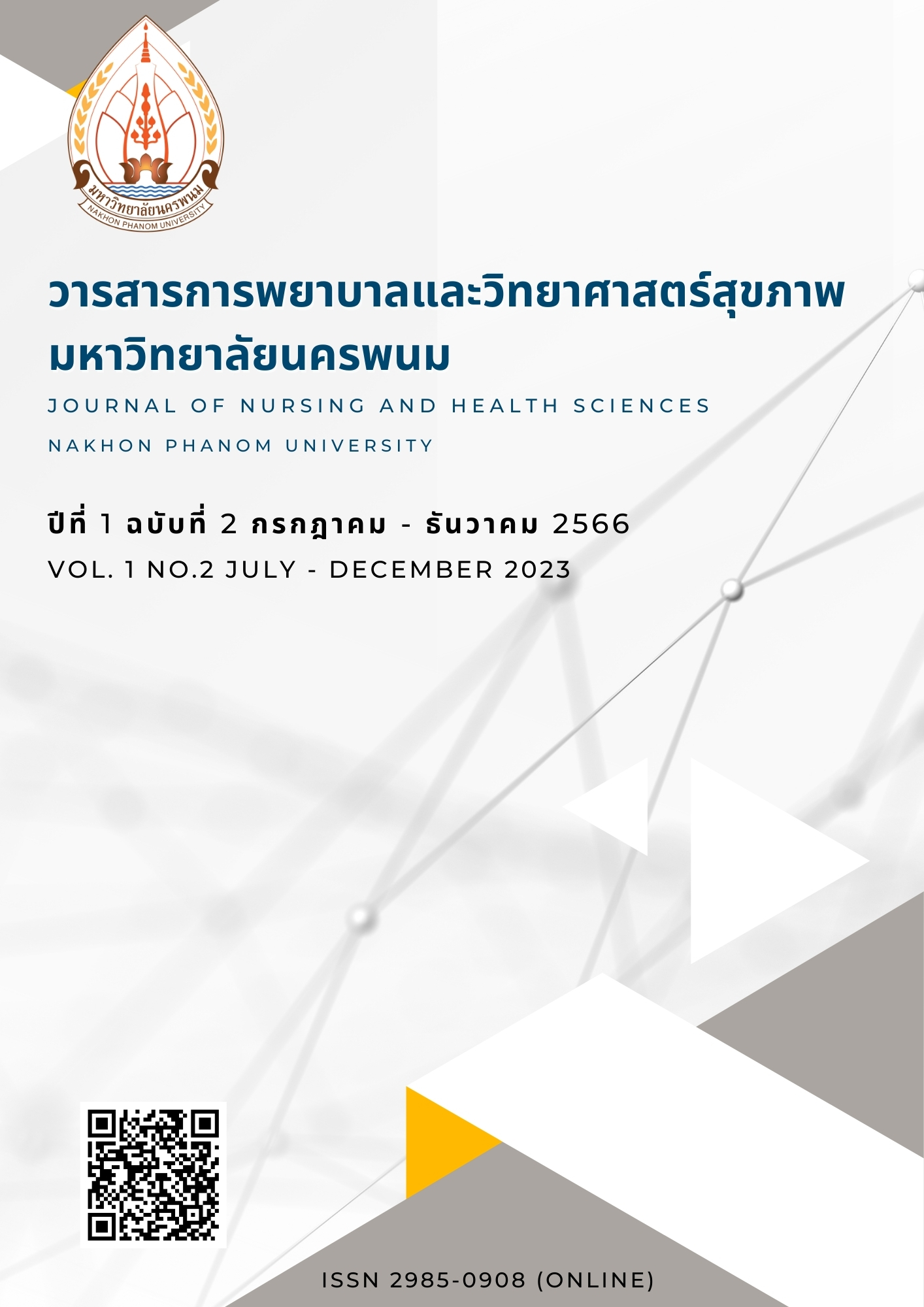ผลของโปรแกรมปรับเปลี่ยนความคิดและพฤติกรรมฉบับย่อผ่านการให้คำปรึกษาแบบกลุ่มต่อทัศนคติ การรับรู้สมรรถนะตนเองและความวิตกกังวลในหญิงตั้งครรภ์ ที่เข้ารับการตรวจคัดกรองกลุ่มอาการดาวน์ในคลินิกฝากครรภ์ โรงพยาบาลมหาสารคาม
The Effect of a Brief Cognitive Program and Behavioral Therapy Through Group Counseling on the Attitudes, Self-efficacy, and Anxiety in Pregnant Women with Down’s Syndrome Screening at the Antenatal Care Clinic, Maha Sarakham Hospital
คำสำคัญ:
โปรแกรมการเรียนรู้เพื่อปรับเปลี่ยนความคิดและพฤติกรรม, การคัดกรองกลุ่มอาการดาวน์บทคัดย่อ
บทคัดย่อ
การศึกษาผลของโปรแกรมปรับเปลี่ยนความคิดและพฤติกรรมแบบกลุ่มฉบับย่อต่อความวิตกกังวลในหญิงตั้งครรภ์ที่เข้ารับการตรวจคัดกรองกลุ่มอาการดาวน์ในแผนกฝากครรภ์โรงพยาบาลมหาสารคาม กลุ่มอาสาสมัครได้จากการสุ่มเข้ากลุ่มทดลอง 36 คนและกลุ่มควบคุม 37 คน ประเมินผลโดยการเปรียบเทียบค่าเฉลี่ยทัศนคติ การรับรู้สมรรถนะตนเอง ความวิตกกังวลต่อการตรวจคัดกรอง การตัดสินใจตรวจคัดกรองและความพึงพอใจต่อโปรแกรม เปรียบเทียบภายในกลุ่มและระหว่างกลุ่มทดลงและกลุ่มควบคุมทั้งในระยะก่อนและหลังการทดลอง วิเคราะห์ข้อมูลเชิงพรรณนาเป็นจำนวน ร้อยละ ค่าเฉลี่ยและส่วนเบี่ยงเบนมาตรฐาน ทดสอบสมมติฐานด้วยการวิเคราะห์ Dependent t – test, independent t-test, chi-square test, Relative risk (RR.) พร้อมประมาณช่วงเชื่อมั่นร้อยละ 95 กำหนดระดับนัยสำคัญในการทดสอบที่ 0.05 ผลการวิจัยมีผู้ข้าร่วมวิจัยกลุ่มทดลองและกลุ่มควบคุมจำนวน 36 คน และ 37 คนตามลำดับ อายุเฉลี่ย 30.8 ปีและ 28.7 ปี ภูมิลำเนาในอำเภอเมืองร้อยละ 44.4 และ 51.3 ตามลำดับ อายุระหว่าง 26-30 ปี ร้อยละ 30.5 และ 29.7 ตามลำดับ ประกอบอาชีพเกษตรกรรมร้อยละ 63.6 และ 58.6 ตามลำดับ ผลการทดลองพบว่ากลุ่มทดลองมีคะแนนเฉลี่ยทัศนคติต่อการตรวจคัดกรอง การรับรู้สมรรถนะตนเองในการตรวจคัดกรองสูงกว่ากลุ่มควบคุมอย่างมีนัยสำคัญ สามารถลดความวิตกกังวลต่อการตรวจคัดกรองในกลุ่มทดลองลงได้มากกว่ากลุ่มควบคุมและสนับสนุนการตัดสินใจตรวจคัดกรองสูงกว่ากลุ่มควบคุม โดยมีความพึงพอใจต่อการเข้าร่วมโปรแกรมระดับสูง ดังนั้นควรนำไปเผยแพร่และเพิ่มโปรแกรมเป็นทางเลือกในคลินิกฝากครรภ์เพื่อส่งเสริมการลดความวิตกกังวลและเพิ่มการตัดสินใจคัดกรองกลุ่มอาการดาวน์ให้มีประสิทธิผลยิ่งขึ้น
References
Boyle B, Addor M-C, Arriola L, Barisic I, Bianchi F, Csáky-Szunyogh M, et al. Estimating global burden of disease due to congenital anomaly: an analysis of european data. Arch Child Fetal Neonatal Ed. 2018;103(1):F2-8.
James S, Afshin A, Agesa K, Alam T, Ballesteros K, Blacker B, et al. Erratum: Global, regional, and national incidence, prevalence, and years lived with disability for 354 diseases and injuries for 195 countries and territories, 1990–2017: a systematic analysis for the global burden of Disease Study 2017. The Lancet. 2018;393(10190):e44-e.
Heaney,S., Tomlinson, M. & Aventin, A. Termination of pregnancy for fetal anomaly: a systematic review of the healthcare experiences and needs of parents. BMC Pregnancy Childbirth. 2022;26(1):441–8.
อัญนลินต์ กมลนันธกิจ, พัชยา เลือดชัยพฤกษ์และณัฐวุฒิ สุทธิประภา. การทำแท้งโดยชอบด้วยกฎหมายกับความคิดเรื่องผิดศีลธรรม. วารสารสังคมศาสตร์เพื่อการพัฒนาท้องถิ่น มหาวิทยาลัยราชภัฏมหาสารคาม. 2565;6(1):301–11.
จันทนา พัฒนเภสัช. การตรวจคัดกรองอาการดาวน์ในหญิงตั้งครรภ์ทุกรายเป๋่็นไปได้. Policy Brief: โครงการประเมินเทคโนโลยีและนโยบายสุขภาพ (HITAP). 2557;2(10):1–4.
สำนักส่งเสริมสุขภาพ กรมอนามัย กระทรวงสาธารณสุข. คู่มือการดำเนินงานการป้องกันการเกิดทารกกลุ่มอาการดาวน์. นนทบุรี: โรงพิมพ์องค์การสงเคราะห์ทหารผ่านศึก; 2563.
Vuorenlehto, L., Hinnelä, K., Äyräs, O., Ulander, V-M., Louhiala, P.& Kaijomaa, MJP. Women’s experiences of counselling in cases of a screen-positive prenatal screening result. PLoS One. 2021;10(16):e0247164.
Chand, S.P.& Marwaha, R. Anxiety. Treasure Island: StatPearls Publishing; 2021.
Soto-Balbuena, C., Rodríguez, M., Gomis, A.E., Ferrer Barriendos, F., Le, H.N. & Grupo PMB-HUCA. Incidence, prevalence and risk factors related to anxiety symptoms during pregnancy. Psicothema. 2018;30(3):257–63.
Rajkumar, R.P. The relationship between access to abortion and mental health in women of childbearing age: analyses of data from the global burden of disease studies. Cureus. 2022;14(11):e31433: 1-11.
Nazmiye, F., Sheikhha, M.H. & Kamali Zarch, M. The Effects of coping therapy on General Health of pregnant women with high risk of Genetics Abnormalities in their Fetus. SSU_Journals. 2018;24(8):607–17.
Hoffmann, N. Attitude Change and Cognitive Therapy. In: Hoffman, N (eds) Foundations of Cognitive Therapy. Boston: Springer; 1984.
Kwon, S-M. & Oei, T.PS. Cognitive change processes in a group cognitive behavior therapy of depression. J Behav Ther Exp Psychiatry. 2003;34(1):73–85.
Fishbein, M. Theory-based Behavior Change Interventions: Comments on Hobbis and Sutton. J Health Psychol. 2005;10(1):27–31.
Haring, M., Smith, J.E., Bodnar, .D., Misri, .S, Little, R.M. & Ryan, D. coping with anxiety during pregnancy and following the birth: A cognitive behaviour therapy-based self-management guide for women and health care providers. Bristis Columbia: BC Reproductive Mental Health Program, a part of BC Mental Health & Addiction Services (BCMHAS), an agency of the Provincial Health Services Authority (PHSA); 2013.
Clinkscales, N., Golds, L., Berlouis, K. & MacBeth, A. The effectiveness of psychological interventions for pregnant women with anxiety in the antenatal period: a systematic review. Psychol Psychother. 2023;96(2):296–327.
Callanan,, F., Tuohy, T., Bright, A.M. & Grealish, A.. The effectiveness of psychological interventions for pregnant women with anxiety in the antenatal period: A systematic review. Midwifery. 2022;104(103169):1–14.
คลินิกฝากครรภ์ กลุ่มงานผู้ป่วยนอก โรงพยาบาลมหาสารคาม. รายงานผลการปฏิบัติงานประจำปีงานฝากครรภ์ แผนกผู้ป่วยนอก โรงพยาบาลมหาสารคาม ปีงบประมาณ 2564-2566. มหาสารคาม: เอกสารอัดสำเนา; 2566.
Chow, S-C., Shao, J., Wang, H., Lokhnygina, Y. Sample Size Calculations in Clinical Research. 3rd ed. New York: Chapman and Hall/CRC; 2017.
Cohen, J. Statistical power analysis for the behavioral sciences. 2nd ed. New York: Lawrence Erlbaum Associates, Publishers; 1988.
Ajzen, I. The Theory of planned behavior. Organ Behav Hum Decis Process. 1991;50(2):179–211.
Bandura, A. Self-efficacy: toward a unifying theory of behavioral change. Psychol Rev. 1977;84(2):191–215.
Spielberger, C.D. Manual for State-Trait Anxiety Inventory (Form Y): Self Evaluation Questionnaire. Palo Alto: Consulting Psychologists Press; 1983.
Dracke, K., Keeton, C.P. & Ginsburg, G.S. Johns Hopkins Psychiatry Guide: Cognitive behavioral therapy (CBT) [Internet]. 2023 [cited 2023 Sep 12]. Available from: https://www.hopkinsguides.com/hopkins/view/Johns_Hopkins_Psychiatry_Guide/787145/all/Cognitive_Behavioral_Therapy__CBT_#0
Hofmann, S.G. , Asmundson, G.J. & Beck, A.T. The science of cognitive therapy . Behav Therapy. Crossref. 2013;44:199–212.
Curtiss, J.E., Levine, D.S, Ander, I. & Baker, A.W.. Cognitive-Behavioral Treatments for Anxiety and Stress-Related Disorders. Focus. 2021;19(2):184–9.
Uguz, F. & Ak, M. Cognitive-behavioral therapy in pregnant women with generalized anxiety disorder: a retrospective cohort study on therapeutic efficacy, gestational age and birth weight. Braz J Psychiatry. 2021;43(1):61–4.
Austin, M.P., Frilingos, M, Lumley, J., Hadzi-Pavlovic, D., Roncolato, W., Acland, S., et al. Brief antenala cognitive-behaviour therapy group intervention for the prevention of postnatal depression and anxiety: a randomised controlled trial. J Affect Disord. 2008;105:35–44.



